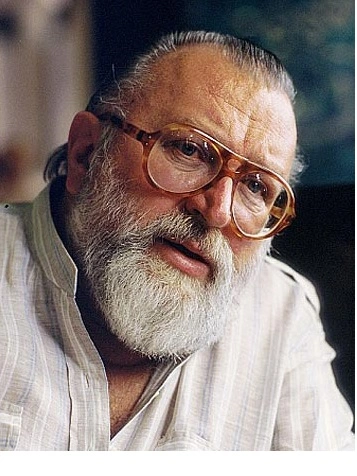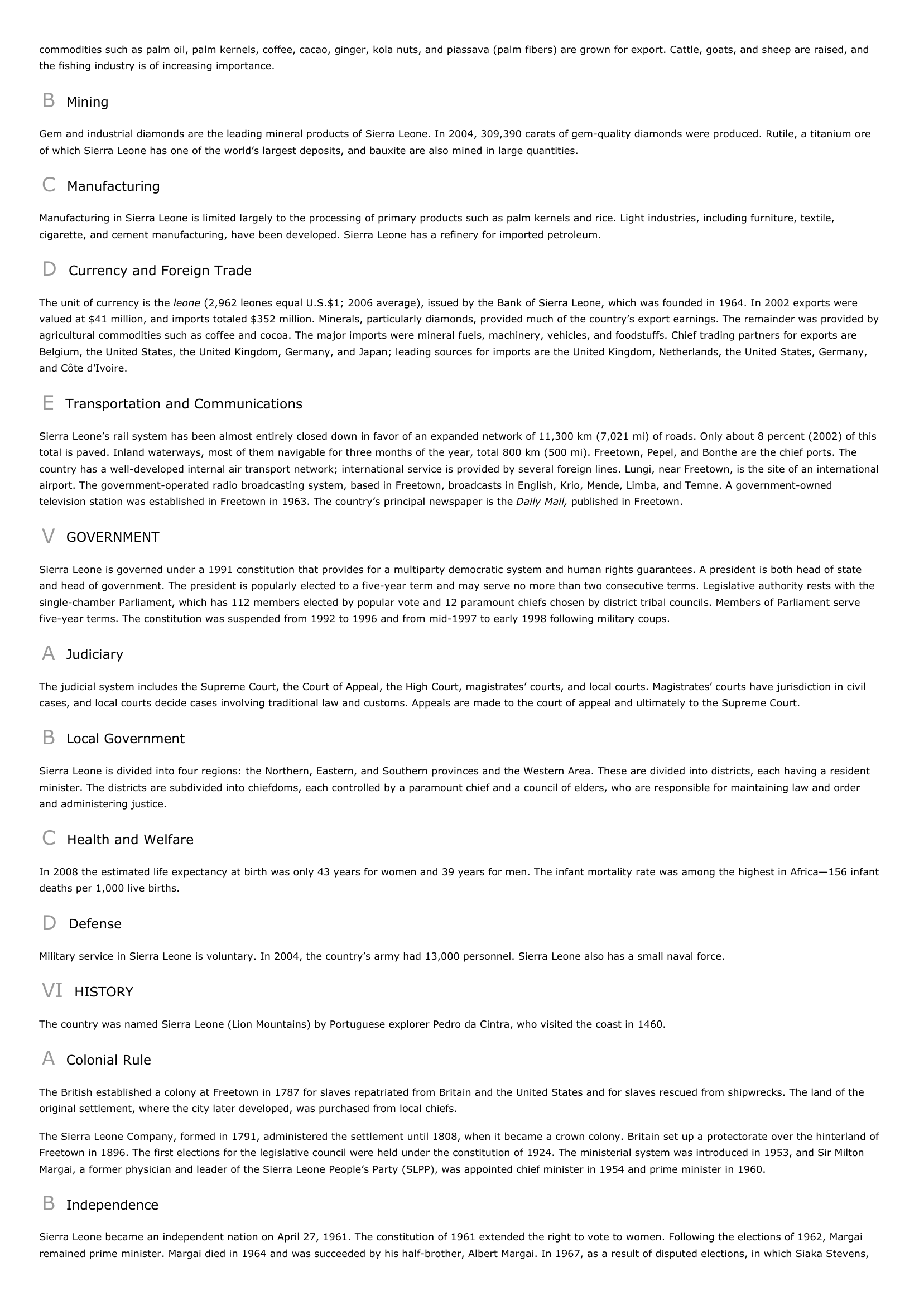Sierra Leone (country) - country.
Publié le 04/05/2013

Extrait du document


«
commodities such as palm oil, palm kernels, coffee, cacao, ginger, kola nuts, and piassava (palm fibers) are grown for export.
Cattle, goats, and sheep are raised, andthe fishing industry is of increasing importance.
B Mining
Gem and industrial diamonds are the leading mineral products of Sierra Leone.
In 2004, 309,390 carats of gem-quality diamonds were produced.
Rutile, a titanium oreof which Sierra Leone has one of the world’s largest deposits, and bauxite are also mined in large quantities.
C Manufacturing
Manufacturing in Sierra Leone is limited largely to the processing of primary products such as palm kernels and rice.
Light industries, including furniture, textile,cigarette, and cement manufacturing, have been developed.
Sierra Leone has a refinery for imported petroleum.
D Currency and Foreign Trade
The unit of currency is the leone (2,962 leones equal U.S.$1; 2006 average), issued by the Bank of Sierra Leone, which was founded in 1964.
In 2002 exports were valued at $41 million, and imports totaled $352 million.
Minerals, particularly diamonds, provided much of the country’s export earnings.
The remainder was provided byagricultural commodities such as coffee and cocoa.
The major imports were mineral fuels, machinery, vehicles, and foodstuffs.
Chief trading partners for exports areBelgium, the United States, the United Kingdom, Germany, and Japan; leading sources for imports are the United Kingdom, Netherlands, the United States, Germany,and Côte d’Ivoire.
E Transportation and Communications
Sierra Leone’s rail system has been almost entirely closed down in favor of an expanded network of 11,300 km (7,021 mi) of roads.
Only about 8 percent (2002) of thistotal is paved.
Inland waterways, most of them navigable for three months of the year, total 800 km (500 mi).
Freetown, Pepel, and Bonthe are the chief ports.
Thecountry has a well-developed internal air transport network; international service is provided by several foreign lines.
Lungi, near Freetown, is the site of an internationalairport.
The government-operated radio broadcasting system, based in Freetown, broadcasts in English, Krio, Mende, Limba, and Temne.
A government-ownedtelevision station was established in Freetown in 1963.
The country’s principal newspaper is the Daily Mail, published in Freetown.
V GOVERNMENT
Sierra Leone is governed under a 1991 constitution that provides for a multiparty democratic system and human rights guarantees.
A president is both head of stateand head of government.
The president is popularly elected to a five-year term and may serve no more than two consecutive terms.
Legislative authority rests with thesingle-chamber Parliament, which has 112 members elected by popular vote and 12 paramount chiefs chosen by district tribal councils.
Members of Parliament servefive-year terms.
The constitution was suspended from 1992 to 1996 and from mid-1997 to early 1998 following military coups.
A Judiciary
The judicial system includes the Supreme Court, the Court of Appeal, the High Court, magistrates’ courts, and local courts.
Magistrates’ courts have jurisdiction in civilcases, and local courts decide cases involving traditional law and customs.
Appeals are made to the court of appeal and ultimately to the Supreme Court.
B Local Government
Sierra Leone is divided into four regions: the Northern, Eastern, and Southern provinces and the Western Area.
These are divided into districts, each having a residentminister.
The districts are subdivided into chiefdoms, each controlled by a paramount chief and a council of elders, who are responsible for maintaining law and orderand administering justice.
C Health and Welfare
In 2008 the estimated life expectancy at birth was only 43 years for women and 39 years for men.
The infant mortality rate was among the highest in Africa—156 infantdeaths per 1,000 live births.
D Defense
Military service in Sierra Leone is voluntary.
In 2004, the country’s army had 13,000 personnel.
Sierra Leone also has a small naval force.
VI HISTORY
The country was named Sierra Leone (Lion Mountains) by Portuguese explorer Pedro da Cintra, who visited the coast in 1460.
A Colonial Rule
The British established a colony at Freetown in 1787 for slaves repatriated from Britain and the United States and for slaves rescued from shipwrecks.
The land of theoriginal settlement, where the city later developed, was purchased from local chiefs.
The Sierra Leone Company, formed in 1791, administered the settlement until 1808, when it became a crown colony.
Britain set up a protectorate over the hinterland ofFreetown in 1896.
The first elections for the legislative council were held under the constitution of 1924.
The ministerial system was introduced in 1953, and Sir MiltonMargai, a former physician and leader of the Sierra Leone People’s Party (SLPP), was appointed chief minister in 1954 and prime minister in 1960.
B Independence
Sierra Leone became an independent nation on April 27, 1961.
The constitution of 1961 extended the right to vote to women.
Following the elections of 1962, Margairemained prime minister.
Margai died in 1964 and was succeeded by his half-brother, Albert Margai.
In 1967, as a result of disputed elections, in which Siaka Stevens,.
»
↓↓↓ APERÇU DU DOCUMENT ↓↓↓
Liens utiles
- Sierra Leone.
- Sierra Leone - geographie.
- Sierra Leone - Daten und Fakten - geographie.
- Sierra Leone Facts and Figures.
- Sierra Leone (fiche pays).
















